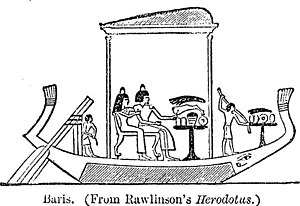Baris(ship)

| |
| General characteristics | |
|---|---|
| Type | Traditional sailing ship |
| Length | 10 m (32 ft 10 in)–30 m (98 ft 5 in) |
| Sail plan | Square rig,papyrusmast |
| Notes | Rudderruns through thehull |
Abaris(Ancient Egyptian:𓃀𓅡𓄿𓏭𓂋𓏤𓊛,romanized:bꜣjr) is a type ofAncient Egyptian ship,whose unique method of construction[1]was described byHerodotus,writing in about450 BC.[2]Archeologists and historians could find no corroboration of his description until the discovery of the remains of such a ship in the waters aroundThonis-HeracleioninAboukir Bayin 2003.
The ship, known asShip 17,the first of 63 ships found in Thonis-Heraclion,[1]measures up to 28 metres (91 feet 10 inches) in length. They were constructed using an unusual technique to join thick wooden planks together, and had a distinctive steering mechanism with an axialrudderpassing through thekeelof thehull.[3][4]Theunderwater archaeologicalwork was carried out byFranck Goddioand theEuropean Institute for Underwater Archaeology,and the findings are being published in a book byAlexander Belovfor theOxford Centre for Maritime Archaeology.[3][4]
Herodotus' description[edit]
The cargo boats are made out of the wood of acacia, which is very similar in appearance to Cyrenean lotus and weeps gum. The way they make these boats is to cut planks of this acacia wood, each about two cubits long, and put them together like bricks. They use long, thick pins to fix these two-cubit planks together, and once the hull has been built this way, they next lay thwarts on top of it. Their boats have no ribbing, but instead they reinforce the fastenings on the inside of the boat with papyrus. They make a single-steering-oar, which is plugged in and through the keel. They use a mast of acacia wood and sails of papyrus. The boats are incapable of sailing upriver without strong following wind; instead, they are towed along from the bank.
Features[edit]

Herodotus reported that barides were built fromacaciawood. Boards about 1 m (3 ft 3 in) long were sawn from the hard wood and the ship's hull was built from them by putting the boards together in a staggered manner. Cross braces stiffened the hull and the joints were sealed withpapyrus.Herodotus emphasized that barides only had one rudder, as Greek ships were always equipped with two oars. There was an opening in the bottom of the ship through which the rudder was passed. They had a mast made of acacia wood with a sail made of papyrus.[5][6]
Ships could only travel up theNileagainst the current when there was a strong northerly wind. Otherwise they would be towed against the current. Downriver, a kind of door made oftamariskwood woven with reeds was used. It was attached to the bow of the ship with a rope and was lowered into the water so that the current pushed against the door and moved the ship. Attached to a second rope at the stern was a pierced stone weighing twotalents(about 52 kilograms or 114 pounds 10 ounces), which was lowered to the bottom of the river. Due to the braking effect, the ship always kept its bow downstream. This type of ship is said to have been very common, and some ships are said to have had a carrying capacity of several thousand talents (1000 talents equals approximately 26tonnes).[5][6]
Barides wereflat-bottomed boatsand could be either sailed or towed;[7]they were never equipped with oars.[8]
Etymology[edit]
Someetymologistsandlinguists[specify]hypothesize that theFrenchwordbarge,whence theEnglishword is derived, as well as theSpanishbarcoand theItalianbarca,may be derived from theVulgar Latinbārica.Bāricacomes from theLatinbāris,which comes from theAncient Greekβᾶρις(bâris), which is the Greek form of the Copticⲃⲁⲁⲣⲉ(baare).[9]It has traditionally been related to theCeltic*par,itself perhaps fromGaulish,from whence was derived the name of theParisii (Gaul)(singularParisius), the Celtictribewhich lends its name to the city ofParis;[10]this argument, however, is etymologically dubious; with several other hypotheses being recorded, including one fromAlfred Holderlinking it to the Parisii to the stem*pario-,meaning "cauldron."[11]
References[edit]
- ^abBelov, Alexander (2014)."A New Type of Construction Evidenced by Ship 17 of Thonis-Heracleion"(PDF).The International Journal of Nautical Archaeology.43(2). Moscow: Center for Egyptological Studies of the Russian Academy of Sciences: 314–329.doi:10.1111/1095-9270.12060.S2CID163142733.Archived fromthe original(PDF)on 2019-03-17.Retrieved2019-03-26.
- ^Solly, Meilan (21 March 2019)."Wreck of Unusual Ship Described by Herodotus Recovered From Nile Delta".Smithsonian Magazine.Archivedfrom the original on 18 January 2024.Retrieved18 January2024.
- ^abAlberge, Dalya (17 March 2019)."Nile Shipwreck Discovery Proves Herodotus Right – After 2,469 Years".The Guardian.Archivedfrom the original on 24 March 2019.Retrieved24 March2019.
- ^abOuellette, Jennifer(24 March 2019)."Shipwreck on Nile Vindicates Greek Historian's Account After 2500 Years".Ars Technica.Archivedfrom the original on 24 March 2019.Retrieved24 March2019.
- ^abcHerodotus(2008).Dewald, Carolyn(ed.).The Histories.Oxford World's Classics. Translated byWaterfield, Robin.Oxford:Oxford University Press.pp. 131, 592–593, 623–624.ISBN978-0-19-953566-8.
- ^abHerodotus(1971).Historien: deutsche Gesamtausgabe.Kröners Taschenausgabe (in German). Translated by Haussig, Hans Wilhelm (4th ed.). Stuttgart: Kröner. pp. 96–97.ISBN978-3-520-22404-0.
- ^Smith, William(2013-03-28).A Dictionary of Greek and Roman Antiquities.Cambridge University Press.doi:10.1017/cbo9781139794602.ISBN978-1-108-06079-0.
- ^Belov, Alexander (2020)."A Note on the Navigation Space of the Baris-Type Ships from Thonis-Heracleion".Sailing from Polis to Empire: Ships in the Eastern Mediterranean during the Hellenistic Period.OBP collection. Cambridge:Open Book Publishers.pp. 91–117.ISBN979-10-365-6304-1.
- ^"Barge".Online Etymology Dictionary.Archivedfrom the original on 18 January 2024.Retrieved18 January2024.
- ^"Paris".Online Etymology Dictionary.Archivedfrom the original on 28 March 2023.Retrieved16 March2023.
- ^Delamarre, Xavier(2003).Dictionnaire de la langue gauloise: une approche linguistique du vieux-celtique continental[Dictionary of the Gaulish Language: A Linguistic Approach to Continental Old Celtic]. Collection des Hespérides (in French) (2nd ed.). Paris: Éditions Errance. p. 247.ISBN978-2-87772-369-5.
Further reading[edit]
- Belov, Alexander (2018).Ship 17: A Baris from Thonis-Heracleion.Oxford Centre for Maritime Archaeology.ISBN9781905905362.
- Belov, Alexander (March 2014). "New Evidence for the Steering System of the EgyptianBaris(Herodotus 2.96) ".International Journal of Nautical Archaeology.43(1): 3–9.doi:10.1111/1095-9270.12030.S2CID161769577.
- Herodotus.The History of Herodotus.Translated byRawlinson, George– via The Internet Classics Archive, Massachusetts Institute of Technology.
- Pomey, Patrice (2015)."La batellerie nilotique gréco-romaine d'après la mosaïque de Palestrina".La batellerie égyptienne. Archéologie, histoire, ethnographie.(in French) (34). Alexandria: Centre d’Études Alexandrines: 151–172 – viaAcademia.edu.
